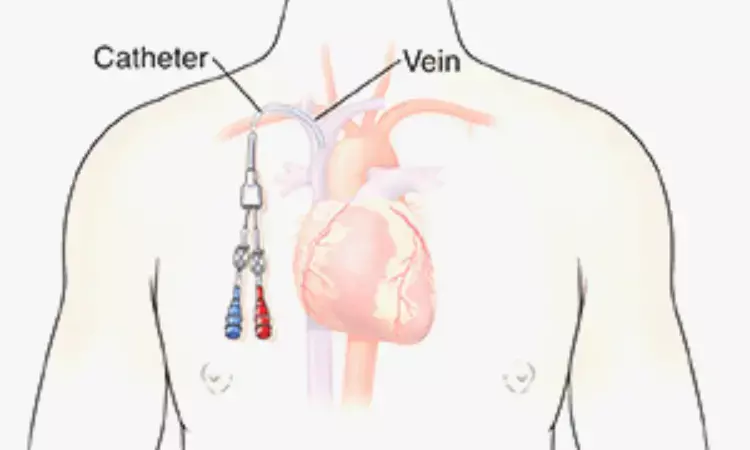- Home
- Medical news & Guidelines
- Anesthesiology
- Cardiology and CTVS
- Critical Care
- Dentistry
- Dermatology
- Diabetes and Endocrinology
- ENT
- Gastroenterology
- Medicine
- Nephrology
- Neurology
- Obstretics-Gynaecology
- Oncology
- Ophthalmology
- Orthopaedics
- Pediatrics-Neonatology
- Psychiatry
- Pulmonology
- Radiology
- Surgery
- Urology
- Laboratory Medicine
- Diet
- Nursing
- Paramedical
- Physiotherapy
- Health news
- Fact Check
- Bone Health Fact Check
- Brain Health Fact Check
- Cancer Related Fact Check
- Child Care Fact Check
- Dental and oral health fact check
- Diabetes and metabolic health fact check
- Diet and Nutrition Fact Check
- Eye and ENT Care Fact Check
- Fitness fact check
- Gut health fact check
- Heart health fact check
- Kidney health fact check
- Medical education fact check
- Men's health fact check
- Respiratory fact check
- Skin and hair care fact check
- Vaccine and Immunization fact check
- Women's health fact check
- AYUSH
- State News
- Andaman and Nicobar Islands
- Andhra Pradesh
- Arunachal Pradesh
- Assam
- Bihar
- Chandigarh
- Chattisgarh
- Dadra and Nagar Haveli
- Daman and Diu
- Delhi
- Goa
- Gujarat
- Haryana
- Himachal Pradesh
- Jammu & Kashmir
- Jharkhand
- Karnataka
- Kerala
- Ladakh
- Lakshadweep
- Madhya Pradesh
- Maharashtra
- Manipur
- Meghalaya
- Mizoram
- Nagaland
- Odisha
- Puducherry
- Punjab
- Rajasthan
- Sikkim
- Tamil Nadu
- Telangana
- Tripura
- Uttar Pradesh
- Uttrakhand
- West Bengal
- Medical Education
- Industry
Supraclavicular route bests infraclavicular route for subclavian vein catheterization

A common invasive technique used to evaluate central venous pressure or administer drugs continuously is central venous catheterization (CVC). Annually, the United States performs around 5 million CVC surgeries. Internal jugular (IJ) and femoral catheterization are known to cause more occurrences of infection, thrombosis, and patient discomfort than subclavian vein catheterization (SVC). However, due to worries of pneumothorax, poor positioning, and subclavian arterial puncture, SVC may be avoided.
SVC typically uses either the supraclavicular (SC) or infraclavicular (IC) techniques. The clavi-sternomastoid angle, a close proximity between the body surface and the vein, a larger target vein domain, a less angular path to the vein, and a greater distance from the lung are all anatomical advantages of the SC approach over the IC approach. To conclusively prove the superiority of the SC technique, a full systematic review employing the GRADE criteria was recently released and used to establish the superiority of the SC strategy.
In May 2022, authors looked for randomised controlled studies to compare the two strategies in the databases of Embase, MEDLINE, CENTRAL, ClinicalTrials.gov, and WHO-ICTRP. 2482 instances from 17 trials were included. The SC approach may slightly reduce the incidence of arterial puncture and pneumothorax (RR, 0.59; 95% CI, 0.29-1.22; I2 = 0%) with low evidence, and it is likely to reduce the failure proportion (relative risk [RR], 0.63; 95% confidence interval [CI], 0.47-0.86; I2 = 5%) and the incidence of malposition (RR, 0.23; 95% CI, 0.13-0.39; I2 = 0%). The SC strategy may shorten access times and boost first-attempt success rates in the secondary outcomes.
The research demonstrated that, with reasonable evidence, the SC technique decreased the failure percentage and incidence of malposition more than the IC strategy. The SC technique may also marginally improve the first-attempt success rate while lowering access time, arterial puncture, and pneumothorax occurrence rates. Strong evidence for the efficacy and safety of the SC method utilizing the GRADE approach is provided by this revised systematic review. This study's clinical implications suggest that when catheterizing the subclavian vein, the SC method should be used. The clavi-sternomastoid angle, for example, is a well-known insertion site that makes it simple to employ the landmark technique in the SC approach. The short distance from the body surface to the vein also makes it simple to see the vein under ultrasound guidance. In addition to providing reliable ultrasound pictures, the vein's superficial placement makes it simple to insert a needle into the vein. The vein is very simple to cannulate and has a broad target area. In light of these anatomical features, the SC method could see fewer failures and quicker access times. In addition, the SC technique, unlike the IC method, does not enter the pectoralis major and makes it simpler to get a long-axis picture and go straight to the vein. The additional anatomical characteristics mentioned above are thought to induce less malpositioning as a consequence. When the CVC is completed by skilled operators, the incidence of problems like pneumothorax has reportedly decreased. Operators who have a lot of expertise with the IC technique may thus find it appropriate. For fresh subclavian venepunctures, people without such expertise should adopt the SC method.
This revised meta-analysis demonstrates that there is modest evidence that the SC technique, as compared to the IC approach, lowers the failure percentage and incidence of malposition.
Reference –
Imai, Eriya1,2,; Watanabe, Jun2,3,4; Okano, Hiromu2,5; Yokozuka, Motoi1. Efficacy and safety of supraclavicular versus infraclavicular approach for subclavian vein catheterisation: An updated systematic review and meta-analysis of randomised controlled trials. Indian Journal of Anaesthesia 67(6):p 486-496, June 2023. | DOI: 10.4103/ija.ija_837_22
MBBS, MD (Anaesthesiology), FNB (Cardiac Anaesthesiology)
Dr Monish Raut is a practicing Cardiac Anesthesiologist. He completed his MBBS at Government Medical College, Nagpur, and pursued his MD in Anesthesiology at BJ Medical College, Pune. Further specializing in Cardiac Anesthesiology, Dr Raut earned his FNB in Cardiac Anesthesiology from Sir Ganga Ram Hospital, Delhi.
Dr Kamal Kant Kohli-MBBS, DTCD- a chest specialist with more than 30 years of practice and a flair for writing clinical articles, Dr Kamal Kant Kohli joined Medical Dialogues as a Chief Editor of Medical News. Besides writing articles, as an editor, he proofreads and verifies all the medical content published on Medical Dialogues including those coming from journals, studies,medical conferences,guidelines etc. Email: drkohli@medicaldialogues.in. Contact no. 011-43720751


